
Building a bridge to space solar power for terrestrial useby David Dunlop and Al Anzaldua
|
| There has been long-term international support for nuclear fusion power research. Can we make a convincing case for developing SBSP for terrestrial use? |
Bridging the enormous gap between the current cost of ground-based power (GBP) and space-based solar power (SBSP) for either space or terrestrial use is a big challenge for advocates of space solar power. On one hand, harnessing the power of the Sun to provide a virtually limitless source of usable energy for civilization is the “Pot-o-Gold at the End of the Rainbow” for this community. On the other hand, one can hardly blame skeptics for questioning the potential of trying to sell something presently ten thousand times more expensive in space than on Earth. One can see why advocating for space solar power has been right up there with catching leprechauns, and why it has been difficult to convince Congress to support research and development for SBSP.
Another potential source for clean power is from commercial fusion, and Arthur Smith describes the ITER (formerly International Thermonuclear Experimental Reactor) research program at a projected capital cost of $40,000 per kilowatt and a consumption cost of $4.70 per kilowatt-hour. The ITER program capital cost is some 26 times the cost per kilowatt of a coal-powered plant, while the cost per kilowatt-hour is over 130 times that for coal. But even with this comparative disparity between the commercial market and the projected ITER plant’s consumption cost, there has been long-term international support for nuclear fusion power research. Can we make a convincing case for developing SBSP for terrestrial use? Smith says, “But three to four orders of magnitude [improvement in cost efficiency] is a very large extrapolation, and it will only be believable if we can build a number of intermediate demonstrations to prove these reductions are achievable.”55
Human civilization’s continued existence is not sustainable on a small crowded planet whose environment is being degraded by fossil fuel power generation and the demands of a growing population with rising expectations and finite resources. The mid- to long-term perspective for sustaining civilization calls for what many would see as “miracles” of technology. There are also many prophets of doom. Yet abundant power for all is the practical goal for space solar power advocates. So against this immense gulf between SBSP for terrestrial use and GBP, the prospects are grim—if we don't solve the problem of relative costs between the two types of systems. On the other hand, the rewards are uncountable if we do.
Getting the costs of power in space down by several orders of magnitude is a tall order. Indeed, studies of the feasibility of space solar power as was first proposed by Dr. Peter Glaser have shown SBSP to be economically unfeasible.6,7 More recently, some hope has been provided by the First International Assessment of Space Solar Power, which suggested that the development of this power technology to supply baseload electrical power might be done within the span of two to three decades.8
A bridge of affordable development options is needed to get from what it would cost to produce terrestrial power from space today to producing power at commercial baseload prices on Earth. To begin, we can do some things that are modest and affordable on the ground, which could also lay groundwork for SBSP. We can also do some things that are less modest but still affordable in space to the same effect.
The promise of “clean” power from solar power satellites makes this a “green solution” to the energy supply problems. But is it? Environmental skeptics of large technological projects have often acted to obstruct such efforts and to demand evidence that the purported solutions to energy production are, in fact, benign to the environment. More specifically, wireless power beaming skeptics are likely to advocate for environmental demonstrations based on long-term studies of the impact of power rectennas over agricultural and natural environment test areas.
| Associated disaster-relief supply chains may provide early demonstration targets for SBSP microwave beaming that would also be widely supported by the international community. |
Long-duration microwave trials should address environmental questions about the environmental impact of rectenna systems in a variety of environmental settings. Diverse locations come to mind: the Mt. Erebus overlook of the McMurdo base in Antarctica, the China Lake Naval Research Station in the Mojave Desert in California, or even the Thule Air Force Base in Greenland, where a mountain radar installation overlooks the base. These suggested settings are remote and therefore not susceptible to the not-in-my-back-yard (NIMBY) reactions in more populated areas, and they are on restricted, federally-operated facilities. These demonstrations need, however, to be open, transparent, and peer-reviewed environmental studies so that results are credible and well publicized.
The cost of power connected to disaster-relief supply chains for refugees in remote areas may range from $2 to $3 per kilowatt-hour, some 40 to 60 times commercial baseload power prices.9 Nature and war provide a “conveyor belt” of natural disasters affecting tens of millions of people each year, with transitional power needs lasting several months to years. Associated disaster-relief supply chains may provide early demonstration targets for SBSP microwave beaming that would also be widely supported by the international community.
Another opportunity connected to disaster relief might involve using beamed power transmitted from an offshore ship (as one example) to an aerostat, with retransmission far inland where no power is available. This over-the-horizon wireless power beaming (OTHWPB) could be a way to utilize and mature power-beaming technology that bypasses insecure and expensive GBP. The devastating hurricane in the Philippines in November of 2013 was an example of where this type of beamed power generation could have served humanitarian needs. OTHWPB would not only demonstrate technology for delivering electrical power at a high cost per kilowatt-hour in time-critical situations for disaster and refugee relief, it would also address safe-use concerns and build on the international support that the UN Platform for Space-based Information for Disaster Management and Emergency Response (SPIDER) program has garnered by obtaining space-based imagery of post disaster conditions from Earth observations satellites.10 OTHWBP technology developed on Earth could later be used for point-to-point microwave or laser power supply on the Moon, where high altitude peaks in constant sunlight might provide transmission points to lower elevations in permanently shadowed regions where frozen volatiles could be mined and recovered.
Even a small space solar power demonstrator satellite linked to a terrestrial antenna would be an expensive proposition. However, one evolutionary step could be to build a multipurpose geostationary Earth orbit (GEO) demonstrator platform that could function as a large transponder farm for radio and TV broadcasts, a site for large reception dishes to receive and relay cell phone signals for millions of paying users, a site for refurbishing dead satellites and utilizing space debris as on-orbit construction material for the site itself, and a site to provide and engage with an array of standardized energy collection and transmission modules as suggested in the NASA Institute for Advanced Concepts (NIAC) 2012 study.11
This last function would involve setting up the manufacturing and supply chain for SBSP modules. It would also provide a testbed to optimize efficiencies and reduce costs to levels more in keeping with GBP. Even so, the economic rationale for an energy collection and transmission platform would be more acceptable if it, in its early phases, targeted its power-beaming demonstrations at the very high cost ground niche markets for disaster relief and refugee support, rather than at commercial baseload ground markets.
In 2012, John C. Mankins produced a final report for the NASA Innovative Advanced Concepts (NIAC) program that detailed a scalable, hyper-modular solar power satellite (SPS) concept, which could possibly lead to SBSP for terrestrial use at a cost close to the cost of commercial GPB. Mankins calls his concept SPS-ALPHA, for “Solar Power Satellite by means of Arbitrarily Large Phased Array.”12 To deliver energy to Earth, SPS-ALPHA would typically be based in GEO, where it would intercept sunlight using a collection of individually pointed thin-film mirrors, convert that sunlight across a large radio frequency (RF) aperture into a coherent microwave beam, and transmit the power to rectennas on Earth and in space. (See illustrations and tables below.) The aim and phasing of the coherent microwave beam would be induced by a pilot or guide beam from the microwave receiver or rectenna.
| Although the full capacity of SPS-ALPHA to provide terrestrial power is not given in the report, it appears that the system’s ability to scale up will likely only be limited by production schedules and the number of GEO positions ultimately available to solar power satellites. |
SPS-ALPHA incorporates a number of critical new and emerging technologies, including wireless power transmission using retro-directive RF-phased array with high-efficiency solid-state amplifiers; high-efficiency multi-bandgap photo voltaic (PV) solar cells, employed in a concentrator PV architecture with integrated thermal management; lightweight structural components, applied in various systems and subsystems;13 autonomous robotics in a highly structured environment; and a high-degree of autonomy among individual modules.
Table 7-16 from the report, reproduced below, shows a hypothetical cost for electricity on the ground at approximately $0.09 per kilowatt-hour with a system delivering 2,000 megawatts, enough for approximately 600 homes in the United States. Mankins anticipates that system costs would be driven down by the standardization and increasingly effective mass production of only eight lightweight modules and parts. Decreasing launch costs by “NewSpace” companies, such as SpaceX, would further drive down costs. As presented in this NIAC report, the system could be scaled up and replicated to provide 100 gigawatts, enough for 30 million homes. In many other countries of the world, 100 gigawatts would provide electricity for a much higher number of homes. Although the full capacity of SPS-ALPHA to provide terrestrial power is not given in the report, it appears that the system’s ability to scale up incrementally and be replicated is formidable and will likely only be limited by production schedules and the number of GEO positions ultimately available to solar power satellites.
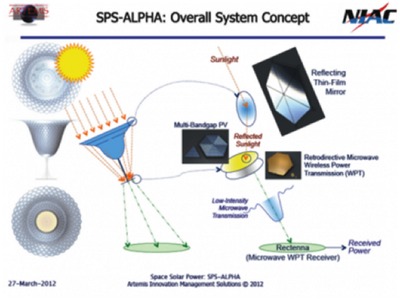 Illustrations, above and below, of the SPS-ALPHA concept. (credit: Artemis Innovation Management Solutions) 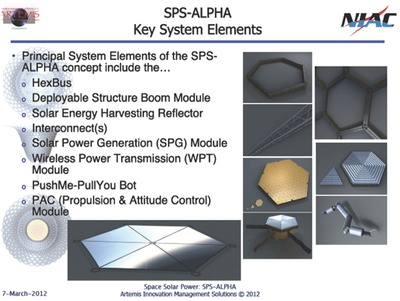 |
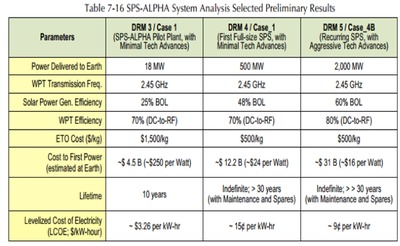 |
Is Mankins being realistic in his projections for eventual single digit cost for SBSP on Earth? To better evaluate this question, it is helpful to look at the historical costs for electrical power. As shown in the first figure below, electricity prices in kilowatt-hours have dropped precipitously since 1905, when power technologies and infrastructure were just being developed. We see the same precipitous drop in cost when PV technology came on to the scene, as illustrated in the second figure below. Electrical power costs have dropped because of the mass production and increasing technological expertise and advancements. Indeed this is the same trend that one sees in computers and other electronics. There is no reason to believe that a similar price decrease will not occur as SBSP systems are developed.
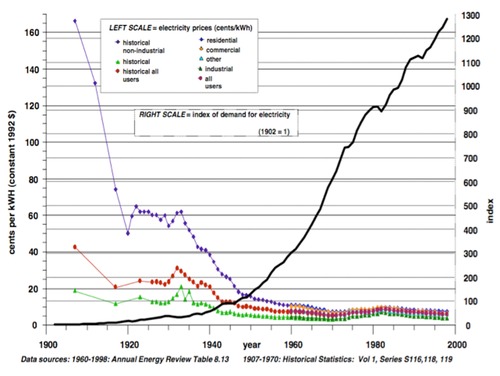 |
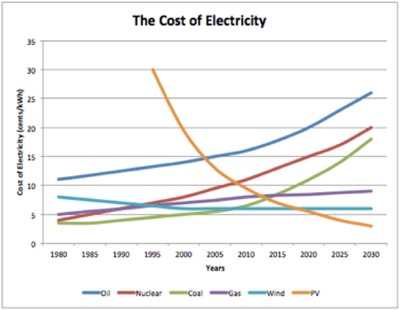 |
Aside from potential humanitarian markets, Al Globus has stated that “space solar power’s greatest weakness is that its profitability depends on supplying very large quantities of power, unless a small niche market willing to pay high prices can be found. One such market might be space-to-space power, i.e., powersats supplying power not to the ground, but to other spacecraft and perhaps the lunar surface.”14 In other words, the path to SBSP for terrestrial use could begin with existing spacecraft in orbit, such as the International Space Station (ISS). In fact, the ISS could provide the main pathway to expanding and reducing the cost of SBSP.
With wise utilization of the ISS, we could test and develop new materials, such as higher-efficiency radiation-hardened photovoltaics with a useful life much longer than current spacecraft materials. Consistent with the existing technology interests and funding programs of the Space Technology Mission Directorate, we could also demonstrate the potential for cost reduction through scalability.15 Gary Barnhard of Xtraordinary Innovative Space Partnerships, Inc. (XISP) maintains that ISS-based development could provide multiple opportunities to test and refine new space power technologies.16 He proposes that the ISS be an early testbed for experiments with modular robotically coordinated space power-beaming constellations. Specifically, Barnhard proposes that we use the station’s Space Communications and Navigation (SCaN) Ka-band 40-watt transmitter to provide a uniform characterizable beam that can be pointed at test targets located at specified distances from the ISS for various periods of time.
| The role of the ISS in space solar power evolution is exciting because its extravagant costs for deployment are already sunk, and plans to continue operations to 2024 creates a time frame adequate for these proposed early demonstrations. |
The objective of beam tests would be to provide augmented power, communications, and attitude control and positioning services. The anticipated targets could be launched from the ISS or other cooperating vehicles. Power transmission, communications, far field/near field effect analysis and management, test of system element interactions (separately and as a system), formation flying and alignment, and various propulsion approaches could be tested and used to the benefit of multiple experiments. Moreover, the SCaN transmitter could also provide augmented power, communications, and some level of attitude control and positioning services to the Japanese H-2 Transfer Vehicle (HTV) or other potential spacecraft, such as Bigelow-proposed tugs. Finally, this combination of equipment could be repurposed for crew‐tended free‐flyers during extended duration microgravity and other experiments.
In sum, the ISS could be used to reduce the cost, technical, and schedule risk associated with using space solar power technology, including loosely coupled modular structure implementation, beam formation, pilot/guide beam testing, and a host of related technology development experiments. Barnhard believes that by doing useful things with the technology in a space-to-space venue, we can simultaneously mature the technology for use in space-to-Earth, space-to-lunar-surface, and space-to-asteroid.
The role of the ISS in space solar power evolution is exciting because its extravagant costs for deployment are already sunk, and plans to continue operations to 2024 creates a time frame adequate for these proposed early demonstrations. Moreover, the ISS contains many features that provide the conditions for an early demonstration of many of the elements of the ALPHA concepts: its own electrical power supply, redundant international supply chain, extravehicular capabilities, robotic grappling and docking, a microwave transmission antenna, and a potential for servicing and refueling other spacecraft. A supplemental demonstration power array could provide a growth path for new ISS capacities and an alternate power supply system if its current system should suffer a major malfunction.
NASA’s Space Technology Mission Directorate (STMD) and Human Exploration and Operations Mission Directorate (HEOMD) are well aligned with elements of John Mankins’ space solar power development strategy. Mankins’ proposed SBSP architecture, which builds on the existing programmatic and budgetary foundations, would:
In general, these proposed demonstrations connected to the ISS provide an affordable near-term opportunity to test architectures for much larger solar power satellites in a way that builds from the smallest practical array and then scales up the number of modules for other energy applications in a variety of cislunar locations. The regular ISS supply chain flights could deliver modules to demonstrate the scalability of SBSP assemblies.
Other research and development projects dealing with refueling spacecraft, SEP, telerobotics and other robotic systems, materials, and operations could work synergistically with SBSP projects. Practical experience could feed back into improved iterations of design, manufacturing, deployment, operations, and redeployment. Reusable rockets and in-space vehicles would also accelerate cost reductions so that the cost trend line for space solar power is steeply downward. Cost efficient strategies might also include launching space power modules as secondary payloads, thus making profitable use of unused lift capacity.
The proposed ISS-connected projects also build on the foundation of international cooperation and partnership, which permit shared participation in the investment, development, and utilization of ISS-connected new technologies. Production facilities could be standardized and evolved among a variety of international supplier partners. The proposed SBSP technology investments and demonstrations would also buy down the risk of commercial investment for large GEO communications platforms interested in using telerobotic servicing, AI-coordinated modular power arrays, or depots needing power to maintain cryogenic storage of propellants.
The proposed ISS-connected architecture could lay the foundation for further evolutionary steps toward large-scale SBSP for use on Earth, in Earth orbits, and even in deep space, where the potential utilization of asteroidal and lunar resources reaches well beyond the ten year time frame of this discussion.
The ISS-connected steps proposed above will advance knowledge for ground systems, in-space applications, and infrastructure requirements for space solar power. There is now at least a ten-year operations window for the ISS. The steps suggested above could likely be approved within that planning timeframe, if an ISS SPS testing and demonstration program consisting of various projects can be quickly initiated. What is being suggested could also broaden international participation so that risks, costs, and benefits are more widely shared. If these steps suggested are taken soon, technological advances to address the challenge of using in-situ resources on the Moon or from near-Earth asteroids may further narrow the price gulf between commercial GBP and SBSP for spacecraft and baseload requirements on the Earth. We believe that the ISS bridge strategy proposed by Barnhard would go a long way toward addressing the requirements mentioned by Smith in 2004 and laid out by Mankins in his 2012 NIAC report.
1 Geoffrey Landis, “Solar Power from Space: Separating Speculation from Reality,” Presented at the XXIth Space Photovoltaic Research and Technology Conference (SPRAT), Cleveland, OH, 6–8 October 2009. Also see Space Quarterly, 11 June 2012.
2 Arthur Smith, “Economic Prerequisites for Space Solar Power,” Proceedings of the 4th International Conference on Solar Power from Space – SPS '04, together with the 5th International Conference on Wireless Power Transmission – WPT (ESA SP-567), 30 June–2 July 2004.
3 A kilowatt (kW) is a unit of power (i.e. rate at which energy is being used). One watt is a joule/sec. A kilowatt-hour (kWh) is a unit of energy.
4 Paul Werbos, “Energy from Space: Challenges Ahead from Technical to Political,” Space Solar Workshop, 2013, IEEE WiSEE/Meeting, Baltimore, November 8–9, 2013, http://sites.ieee.org/wisee/
5 Smith, op. cit., 30 June–2 July 2004.
6 “Solar Power Satellites: An AIAA Position Paper,” American Institute of Aeronautics and Astronautics, 29 November 1978.
7 John C. Mankins, “A Fresh Look at Space Solar Power: New Architectures, Concepts, and Technologies,” International Astronautical Federation, IAF-97-R.2.03, 12 pages, 1997.
8 First International Assessment of Space Solar Power, IAA, 2011.
9 Paul Jaffe and Steven Blank, “Meeting the Challenges with Space Solar Power,” IEEE WiSEE, Space Solar Power Workshop, Baltimore, 8–9 November 2013.
10 United Nations Platform for Space-based Information for Disaster Management and Emergency Response - UN-SPIDER Knowledge Portal, www.un-spider.org. LPI Contribution No. 1748 Annual Meeting of the Lunar Exploration Analysis Group October 14–16, 2013, Laurel, Maryland, Lunar and Planetary Institute.
11 John C. Mankins, SPS-ALPHA: The First Practical Solar Power Satellite via Arbitrarily Large Phased Array (a 2011-2012 NASA NIAC Phase One Project), Final Report to NASA, pps. 53–57, 15 September 2012.
12 Mankins, op. cit. 2012, pps. 5–6. The description of SPS-ALPHA is taken almost verbatim from the report.
13 All modules and other parts are less than 100 kilograms, except for propulsion/attitude control modules, which could hold up to 455 kilograms of fuel.
14 Al Globus, “In Defense of Solar Power,” http://space.alglobus.net/papers/FetterResponse.html.
15 Glenn Research Center, “ NASA RFI Support of Low Cost Solar Array Technologies in Support of High Power Solar Electric Propulsion,” December 20, 2013, Solicitation Number NNC14ZCH012L, NIACS Code 541712.
16 Gary Barnhard, “Space-to-Space Beamed Power,” presented at Space Solar Power (SSP 2014) Kobe, Japan April 15, 2014. The work referenced pertains to "Annex 7 – Space-to-Space/Surface Power Beaming,” of a NASA-Xtraordinary Innovative Space Partnerships, Inc. Space Act Umbrella Agreement under negotiation (http://www.xisp-inc.com/index-6-projects.html), 2014.